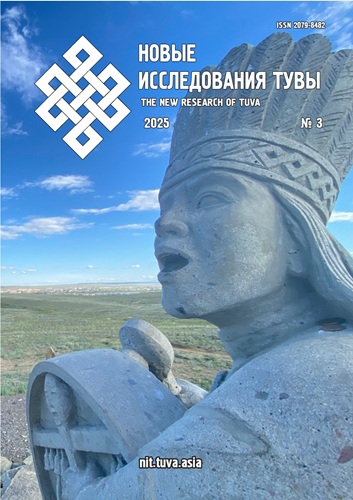The Sonnets of M. B. Kenin-Lopsan as a Formula for the Worldview of the Tuvan People
DOI:
https://doi.org/10.25178/nit.2025.3.2Keywords:
Mongush Borakhovich Kenin-Lopsan; Tuvan culture; sonnet; sonnet cycle; genre; mythopoeticsAbstract
This article analyzes the sonnets of the renowned Tuvan poet, writer, philosopher, cultural scholar, scientist, and shaman Mongush Borakhovich Kenin-Lopsan. The material for the study comprises sonnets published in his book Tölge [Fate] (2011), translated into Russian by I. Fonyakov.
In the creative work of M. B. Kenin-Lopsan, the sonnet attains a transformative form that transcends the boundaries of literature and emerges as a unique phenomenon of Tuvan culture. The aim and innovative aspect of this research lie in the examination of the sonnet form as shaped by a distinct gift of shamanic perception of reality and its reproduction within the genre framework.
The structure of the article reflects the nature of transformation across the genre-forming layers of the sonnet. The organization of space and time in the sonnets primarily invokes a subjective and associative framework. It reveals the workings of the consciousness of a spiritually elevated protagonist undergoing the Tolstoyan process of “simplification” in search of dissolution within the eternal polyphony of nature. The associative context emphasizes the significance of ethnographic imagery and terminology as key semantic markers that guide the author's thought toward concrete observations and generalizations. The spatiotemporal structure bridges the sonnet's world-model with the mythopoetic one, leading to an understanding of the idea of human–nature unity as a core element of Tuvan cultural worldview. The analysis of metrorhythmic and poetico-aesthetic organization enabled comparisons between the original and translated texts, highlighting how the poetics of the Tuvan language shape and transmit the philosophical ideas of the sonnet.
The study of the genre characteristics of M. B. Kenin-Lopsan’s sonnets uncovers a central feature of the form: the sonnet functions as a necessary philosophical "bond," expressing humanity’s capacity to transcend the rapid flow of life and reach the value of eternal categories embedded in cultural and national worldviews. By uniting the sonnets into a cohesive cycle, the poet creates an epic narrative of return to origins as the sole path toward preserving human spirituality.
References
Bady-Suur, N. D. (2015) Mongush Kenin-Lopsan — the living heritage of shamanism. Novaya nauka: Sovremennoe sostoyanie i puti razvitiya, no. 1, pp. 103–106. (In Russ.)
Bekher, I. (1981) My Love, Poetry… On Literature and Art. Moscow, Khudozhestvennaya Literatura. 527 p. (In Russ.)
Volkov, I. F. (1995) Theory of Literature. Moscow, Vlados. 256 p. (In Russ.)
Gulyaev, N. A. (1985) Theory of Literature. Moscow, Vysshaya Shkola. 272 p. (In Russ.)
Dampilova, L. S. (2013) The mythologeme of memory in the poetry of Mongush Kenin-Lopsan. Sibirskii filologicheskii zhurnal, no. 4, pp. 132–138. (In Russ.)
Donskaya, E. L. (1988) On the genesis and development of the English sonnet of the 16th century. Filologicheskie nauki, no. 2, pp. 30–34. (In Russ.)
Komby, S. S. (2002) Foreword. In: Anthology of Tuvan sonnets / comp. by S. S. Komby. Kyzyl, Tyvanyng nom ündürer cheri. 144 p. Pp. 3–14. (In Russ.)
Komby, S. S. (2014) The first novel in Tuvan literature. Vestnik Khakasskogo gosudarstvennogo universiteta im. N. F. Katanova, no. 7, pp. 49–52. (In Russ.)
Kuzhuget, A. K. (2020) The culturological aspect of the scientific work of M. B. Kenin-Lopsan. Polilingval’nost’ i transkul’turnye praktiki, vol. 17, no. 4, pp. 454–461. (In Russ.) DOI: https://doi.org/10.22363/2618-897X-2020-17-4-454-461
Madyukova, S. A. and Popkov, Yu. V. (2010) The Phenomenon of Sociocultural Neotraditionalism. St. Petersburg, Aleteiya. 132 p. (In Russ.)
Mizhit, L. S. (2022) Achievements of Tuvan literature during the Soviet period. Aziatskie issledovaniya: istoriya i sovremennost’, no. 1, pp. 73–85. (In Russ.)
Pospelov, G. N. (1976) Introduction to Literary Studies. Moscow, Vysshaya Shkola. 422 p. (In Russ.)
Samdan, Z. B. (2019) Modification of the archetypal image of the Tuvan shaman in the works of M. B. Kenin-Lopsan. New Research of Tuva, no. 3, pp. 158–171. (In Russ.) DOI: https://doi.org/10.25178/nit.2019.3.13
Soyan, A. M. (2020) The image of grandmother Duruyaa in the novel by M. Kenin-Lopsan “The Herdsman’s Yurt”. In: Fundamental Foundations of Innovative Development of Science and Education: Collection of Articles of the IX International Scientific-Practical Conference, Held on December 25, 2020 / ed. by G. Yu. Gulyaev. Penza, MTSNS “Nauka i Prosveshchenie”. 278 p. Pp. 134–136. (In Russ.)
Skvoznikov, V. D. (1964) Lyric poetry. In: Theory of Literature. Main Problems in Historical Perspective. Genres and Types of Literature / ed. by G. L. Abramovich et al. Moscow, Sovetskii Pisatel’. Book II. 488 p. Pp. 173–238. (In Russ.)
Toburukov, N. N. (2021) Interrelation and mutual influence of the peoples of Siberia. Vestnik Severo-vostochnogo federal’nogo universiteta im. M. K. Ammosova. Seriya: Voprosy natsional’nykh literatur, no. 3, pp. 42–61. (In Russ.)
Tolysbayeva, Zh. Zh. (2008) The Sonnet in the Poetry of Kazakhstan at the End of the 20th and the Beginning of the 21st Centuries. Semey, Talant. 68 p. (In Russ.)
Khalizev, V. E. (1999) Theory of Literature. Moscow, Vysshaya Shkola. 400 p. (In Russ.)
Falk, M. (2024) Lyric: Self-Abnegation in the Sonnets of Clare and Smith. In: Falk M. Romanticism and the Contingent Self. The Challenge of Representation / Palgrave Studies in the Enlightenment, Romanticism and Cultures of Print. Palgrave Macmillan, Cham. 292 p. Pp. 129–182. DOI: https://doi.org/10.1007/978-3-031-49959-3_4
Guissin-Stubbs, T. (2020) The Modern Irish Sonnet. Revision and Rebellion / Series Ed. K. Matthews. Palgrave Macmillan Cham. 256 p. DOI: https://doi.org/10.1007/978-3-030-53242-0
Moy, O. L. (2023) Nineteenth-Century Sonnet Contests and Parlor Games: “Leafiness” and Bits of Rhyme. In: Behlman L. and Loksing Moy, O. (eds) Victorian Verse. The Poetics of Everyday Life. Palgrave Macmillan, Cham. 289 p. Pp. 229–252. DOI: https://doi.org/10.1007/978-3-031-29696-3_12
Steenson, A. L. and Trissino, L. (2023) A Stylistic Analysis of Montale’s Version of Sonnet 33: Translation, Petrarchism and Innovation in Modern Italian Poetry. In: Kingsley-Smith J. and Rampone Jr., W. R. (eds) Shakespeare’s Global Sonnets. Translation, Appropriation, Performance. Cham, Palgrave Macmillan. 408 p. Pp. 53–70. DOI: https://doi.org/10.1007/978-3-031-09472-9_4
Szele, B. (2023) “Far from Variation or Quick Change”: Classical and New Translations of Shakespeare’s Sonnets in Hungary. In: Kingsley-Smith J. and Rampone Jr., W. R. (eds) Shakespeare’s Global Sonnets. Translation, Appropriation, Performance. Cham, Palgrave Macmillan. 408 p. Pp. 89–106. DOI: https://doi.org/10.1007/978-3-031-09472-9_6
Published
How to Cite
For citation:
Tolysbaeva Zh. Zh. The Sonnets of M. B. Kenin-Lopsan as a Formula for the Worldview of the Tuvan People. New Research of Tuva, 2025, no. 3, pp. 20-41. (In Russ.). DOI: https://doi.org/10.25178/nit.2025.3.2
Issue
Section

This work is licensed under a Creative Commons Attribution-NonCommercial 4.0 International License.

Author(s) license holder(s) grant rights for their work to the journal (grantee of a license) under the simple non-exclusive open license in accordance with Art. 1286.1 «Open license for a research work, work of literature or fine arts», Civil Code of the Russian Federation.
New Research of Tuva publishes articles under the Creative Commons Attribution-NonCommercial license (CC BY-NC).
Since it is an open license, author(s) reserve the right to upload the article to their institutional repository, submit it to another journal (if it allows republications), or republish it on their own website (in full, or in part).
However, several conditions apply here:
a) The republished version must always contain the name(s) and affiliation(s) of the author(s), the original title and the hyperlink to the original version on the New Research of Tuva website;
b) It must be in open access, free of charge, and no category of readers must be in any way whatsoever advantaged over general readership.
c) should the contribution be submitted elsewhere by its author(s) without substantial modification (30% or more of original text unchanged), the body of the article should contain a disclaimer that the original version was published in New Research of Tuva (with a link to the respective page)
The CC-BY-NC is a non-revocable license which applies worldwide and lasts for the duration of the work’s copyright.









